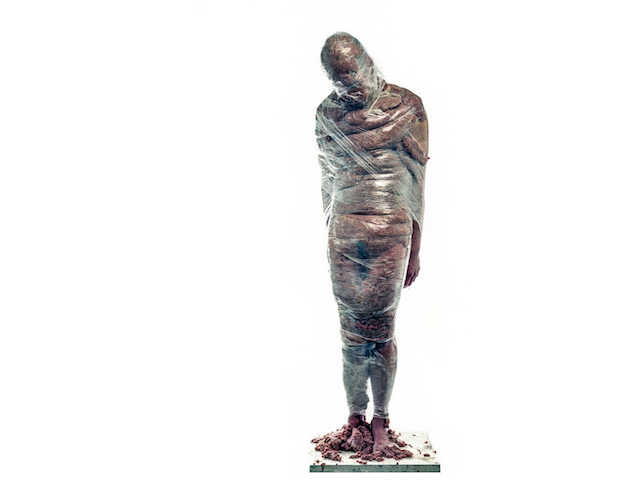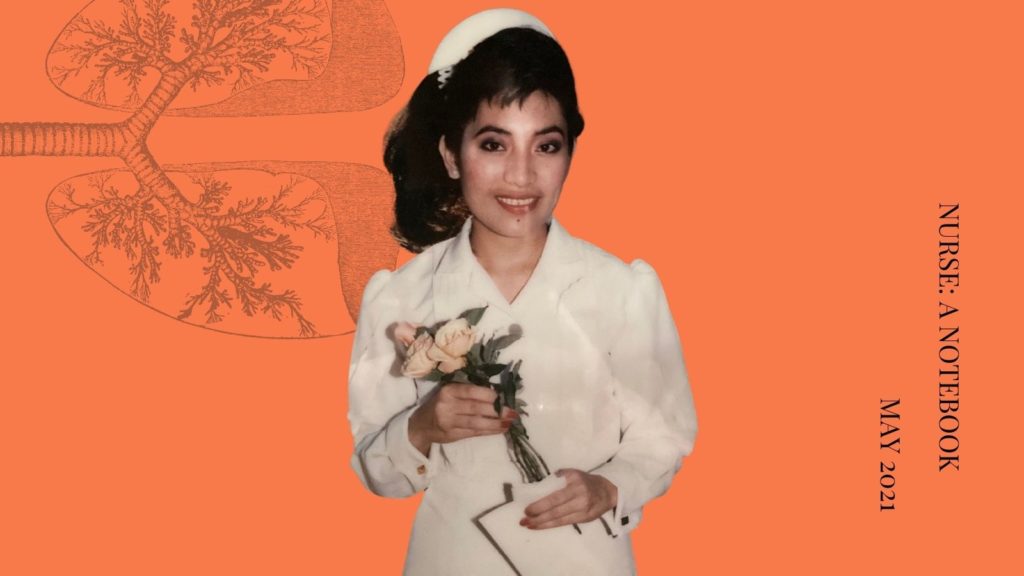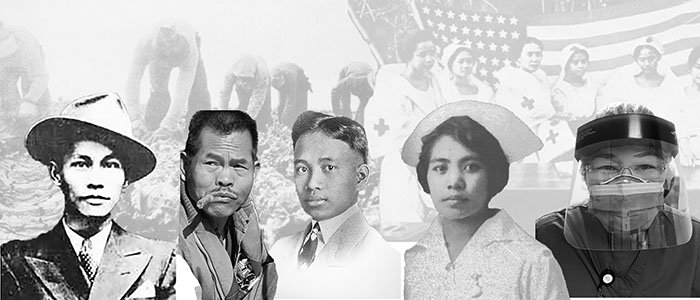You want more than the count of their lives lost

May 17, 2021
Editor’s Note: The following essay by Catherine Ceniza Choy is part of a notebook of writing on the theme Nurse. Read other pieces in the collection gathered here.
When the reporter asks you why so many of the nurses in the U.S. who have died from COVID-19 were from the Philippines, you know that her question emerges from recent news coverage about the disproportionate numbers of their deaths. In a September 2020 report, National Nurses United noted that 31.5 percent of registered nurses who have died are Filipino, even though this group comprises only 4 percent of the RN workforce. The reporter poses this question to you, the author of a book on the history of Filipino nurse migration.
You realize that your research is caught in a moment of intense hypervisibility and invisibility. Among the Filipino nurses who have died were people like Araceli Buendia Ilagan and Noel Sinkiat who had been working in U.S. hospitals for over thirty years. The presence of Filipino nurses in the United States is a longstanding one. Yet the reporter’s questions suggest that the general public is wondering for the first time why there are so many Filipino nurses in the U.S.
Filipino nurses are an indelible part of your personal history, of memories that you hold as a child growing up in Stuyvesant Town-Peter Cooper Village in Manhattan. The large apartment housing complex was steps away from Mount Sinai’s Beth Israel Hospital and New York Eye and Ear Infirmary. It was not too far from Bellevue Hospital, the oldest public hospital and one of the largest in the United States.
In the 1970s, your mother greeted her kababayan or fellow Filipinos by the mailboxes or in the elevator. You learned then that many of your Filipino neighbors were nurses. They no longer wore the tell-tale nursing caps, but they were wearing white uniforms, hospital badges, and comfortable shoes.
It would involve leaving New York City for you to learn more about the history of Filipino nurses there. In the late 1980s, you attended Pomona College in Claremont, California. You were curious about U.S. immigration history, but you did not see your community’s history reflected in the scholarship. You reflected upon your childhood and asked a seemingly straightforward question: Why were there so many Filipino nurses?
You started to read the sociological literature on the post-1965 professional immigration from Asia to the United States and about the brain drain of health professionals from poorer to richer nations. You realized that your childhood observations have global dimensions. In the late 20th century, the Philippines became the world’s leading exporter of nurses, sending nurses to the U.K., Japan, and the Middle East as well as the United States.
This is why decades later, in December 2020, when you learn that the first person in the world to deliver a Covid-19 vaccine outside of a clinical trial is a Filipino British nurse named May Parsons, who has worked in the UK’s National Health Service for over 20 years, you are unsurprised. Unsurprised that she has worked overseas for that long. Unsurprised that she speaks with a British accent as she thanks all health workers and the Filipino British community. You are proud of her for making history and you are grateful to the entire Filipino nursing diaspora for being the backbone of health care delivery systems around the world, well before and during this pandemic.
In the 1990s, when you were in a doctoral program in history at UCLA, you posed this question for your dissertation: Why has the developing country of the Philippines provided professional nursing care for highly developed countries like the United States?
When the reporter asks this same question, you explain that the international migration of Filipino nurses has a long and unequal history steeped in early-20th-century U.S. colonialism in the Philippines. You go on to say that, in a classic example of cultural imperialism, American officials justified the colonization of the archipelago with claims of bringing public health to the islands. The U.S. policy of benevolent assimilation included the establishment of an Americanized training hospital system in the Philippines that followed U.S. professional nursing trends. Graduates of these nursing schools had to demonstrate fluency in the English language in order to obtain Philippine nursing licensure.
When the reporter asks you if American colonizers had created this labor force in order to alleviate U.S. nursing shortages, you clarify that this was not their original intent. But that is what happened throughout the second half of the 20th century. Americanized nursing training and English language fluency prepared tens of thousands of Filipino nurse graduates to work overseas. Since the 1960s, over 150,000 Filipino nurses have provided a critical source of labor for large urban and public hospitals primarily in the states of New York, New Jersey, California, Texas, Florida, and Massachusetts.
You explain that their adjustment to their American workplaces was not easy, however. Although American hospitals had sponsored them as exchange visitor nurses after 1948 or recruited them as permanent employees after 1965, many pioneering Filipino nurse migrants had to turn to one another and to relatives and friends already in the United States for help. You share the story of Fortunata Kennedy, who one day in 1964 arrived in the United States with 15 other Filipino exchange nurses. They were supposed to have had accommodations at a local YMCA, but when they got there, the clerk denied having ever received their reservations. Many of them had no choice but to share one small room. The following day, one of the nurses was able to contact a friend in Chicago, who helped them find a place to stay. In your oral history interview with Fortune (as she prefers to be called), she makes an impression on you when she relates, “Our initiative and determination made us survive the first few difficult years.”
At the heart of your research are 43 in-depth oral interviews with Filipino nurses who trained in the Philippines, but were working as registered nurses in the United States. Forty of these interviews are with Filipino nurses working in New York City. By the mid-1990s, Filipinos comprised 18 percent of RN staff in New York City’s hospitals. Listening to their stories, you have learned about their American dreams of seeing snow and where apples grow, which they had read about in books from their Filipino childhoods. As these nurses grew older, U.S. soft power fueled their desires to attend Broadway musicals and their hopes of encountering Hollywood movie stars. In your interview with Epifanio Mercado, she expresses a sense of excitement and adventure, when she tells you that, in the United States, “you can go to Broadway, Lincoln Center. You have enough money to travel. There’s always something going on.”
Many Filipino nurses’ stories of adjustment feature the English language, even though their proficiency enabled their migration and employment. Some of the Filipino nurses you interview tell you that they had to adjust to different American accents, like a southern accent. That a ringing telephone on the hospital floor could create so much anxiety that they would walk quickly away from it so as not to have to pick it up. That they didn’t understand colloquial phrases like “coffee break.” As one Filipino nurse shares with you, “At first, I said no to coffee breaks with my coworkers because I didn’t like coffee.”
You laugh along with them as they reminisce about those initial misunderstandings. But you also realize that what seems lighthearted now was probably disconcerting then. And, upon reflection, your admiration of these Filipino nurses grows because their seemingly mundane stories reflect perseverance and grit. You imagine how hard it must have been to have achieved so much specialized training and to have gained proficiency in at least two languages (English and at least one of the many Filipino vernaculars), and then to have moved across a vast ocean to find yourself bewildered by the local variations and nuances of everyday communication.
When the reporter asks you why there were so many Filipino nurses migrating to the US beginning in the 1960s, you explain that a confluence of Great Society programs, social movements, and new immigration policies increased the demand for nursing services, resulted in nursing shortages, and encouraged the immigration of foreign-trained nurses. As American women entered professions that had previously excluded them, U.S. hospitals looked overseas to alleviate nursing shortages especially in hard-to-recruit areas and work shifts that serve the most vulnerable American populations. In your archival research, you find this history materialized in a Chicago hospital’s 1969 advertisement in the Philippine Journal of Nursing beckoning Filipino readers that “there’s a job waiting for you.”
America’s need for nurses presented them an opportunity to fulfill social and cultural as well as economic longings. Yet, as you listen more deeply, you recognize darker historical patterns regarding the treatment of immigrant workers. In the mid-1970s, two Filipino immigrant nurses, Filipina Narciso and Leonora Perez, were wrongfully convicted of conspiracy and poisoning their patients in the case of the V.A. (Veterans Administration) murders in Ann Arbor, Michigan. In your interview with Milagros Rabara, you ask her if she recalls this case. She tells you that she thought they were not guilty “because there were other nurses on the floor and I don’t know why these two were singled out.”
Filipino nurses’ stories also reveal fraudulent recruitment practices, work exploitation, and formidable licensure requirements. In 1974, Elvie Santos (not her real name) faced deportation because she had entered the United States on a temporary work visa, but was unable to pass the U.S. nursing licensure examination. She had paid fees to a recruitment agency in order to work as a nurse in the U.S.. But the agency assigned her work as a nurses’ aide in a nursing home instead. She lamented, “I first came to the United States . . . with the understanding that I would work as a nurse and make money—much more [than] what I was receiving in the Philippines. I am so disappointed at the outcome . . . and now I am wondering if my coming here is worth leaving my family behind.”
In 1998, Billy Denver Jewell, Holly Arthur Estreller, Sidney and Veronica Hewitt, and Haesook Kim pleaded guilty to illegally bringing hundreds of registered nurses from the Philippines to work as nursing assistants in convalescent homes and other medical facilities for as little as $5 per hour. Another egregious example of fraud and discrimination was the employment of 65 Filipino nurses in Woodbine Healthcare Center, a nursing home in Gladstone, Missouri. In the mid-1990s, Woodbine petitioned the U.S. Immigration and Naturalization Service to hire Filipino nurses in its nursing home with the promise that it would employ them as registered nurses and pay them the same wages as U.S. nurses. However, the Filipino nurses worked as nursing aides and Woodbine paid them about $6.00 an hour less than their U.S. counterparts. Two Filipino nurses filed discrimination charges with the U.S. Equal Employment Opportunity Commission and, in 1999, Woodbine agreed to pay $2.1 million to the nurses and their attorneys.
Filipino nurses’ need to organize with other Filipinos and with other nurses in order to demand fair treatment, and to make themselves visible in the U.S. nursing profession specifically and American society more broadly, is a common refrain. And they did organize. In the 1960s and 1970s, Filipino nurses created local Philippine Nurses Associations from New York to Illinois to California. Today, the Philippine Nurses Association of America and its foundation have initiated the Heal Our Nurses Project and a COVID-19 Task Force to assess the well-being of their members and the impact of the pandemic on their profession.
Your book about the history of Filipino nurse migration is published in 2003, sixteen years before the emergence of this novel coronavirus. In the epilogue you note that despite attempts to end the recruitment of foreign nurses in the U.S., their recruitment continues in the wake of disasters. In April 2020, you read President Donald Trump’s proclamation on suspending U.S. immigration. You observe in the fine print that it shall not apply to persons seeking to immigrate to the United States as nurses or other healthcare professionals. You recognize that Filipino nurses continue to be part of a difficult American history. This history is repeating itself by relying on immigrant laborers in times of crisis while vilifying them.
You know that the interview will end when the reporter says that she has two more questions: How did hearing this news make you feel? Is there anything else you want our readers to know? When the reporter asks you these questions, your voice cracks, but you have to steel yourself. Because you want the world to know that these Filipino nurses are courageous human beings. And you want more than the count of their lives lost. You want their lives to count.



